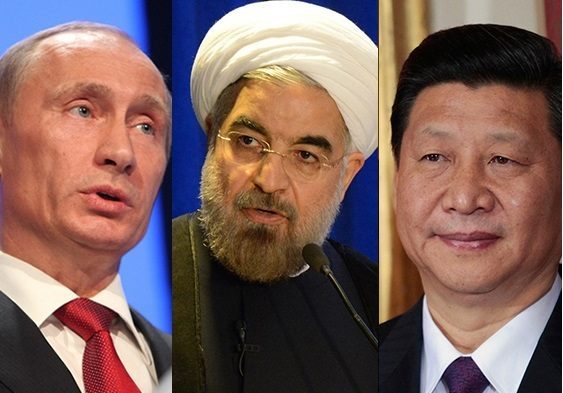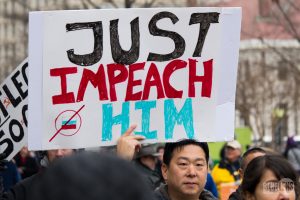by Esfandyar Batmanghelidj
“Today, Russia and China effectively shelter Iran from complete isolation and provide it with political support, defence assistance, and economic ties it cannot receive elsewhere.” That is the primary contention of a new book by Dina Esfandiary, a research fellow at Harvard’s Belfer Center for Science and International Affairs, and Ariane Tabatabai, an assistant professor at Georgetown University’s School of Foreign Service.
Triple Axis (I.B. Tauris) explores “Iran’s ability to leverage its relations with Russia and China” as part of the Islamic Republic’s “struggle to challenge the world order.” The book is divided into five sections. First, the authors examine Iran’s position in the world order and the shared project of a Russian-Chinese-Iranian bulwark against the West. Second, the authors chart Iran’s evolving political relations with the two powers from the Cold War through the negotiations which led to the Joint Comprehensive Plan of Action (JCPOA). Third, they discuss economic ties, with a particular focus on the increasing presence of Chinese enterprises in Iran’s economy. Fourth, they examine defense and security cooperation, with an in-depth look at Iran-Russia cooperation in Syria. Finally, they conclude by looking to the “post-JCPOA” prospects for the triple axis, particularly in the face of a breakdown in the cohesion of American and European foreign policy towards Iran. It is in this last section that Triple Axis becomes theoretically most interesting.
Esfandiary and Tabatabai bring their narrative up to the present day when European policymakers are scrambling to save the JCPOA following President Trump’s withdrawal from the deal in May. Iran is rightly concerned that the reimposition of US secondary sanctions will further stymie the already slow rebound in trade and investment that underpinned the quid-pro-quo of the nuclear deal. Even as Europe seeks to define—for the first time in a decade—an Iran policy independent from that of the United States, it will likely prove unable to mitigate the harm of the returning sanctions. By all accounts, the Trump administration’s financial war is going as planned, as Iran’s currency plummets in value and shortages in key goods contribute to widespread protests. In this environment, Russian and Chinese companies, less concerned with the risk of US sanctions, will once again prove Iran’s lifeline.
Russian and Chinese efforts to sustain Iran economically, in the absence of significant Western trade or investment, will “translate into more intertwined interests” that combine basic commercial opportunities with larger political and military interests. Ultimately Russia and China will face “greater difficulty in walking away” from the alliance. Consequently, Esfandiary and Tabatabai see the crisis surrounding the nuclear deal as accelerating a process that will “effectively make any future Western attempts to isolate Iran unfeasible.”
The notion that American efforts to isolate Iran are tantamount to America isolating itself is now a ubiquitous touchpoint in policy analysis on Iran. In one recent example, a Newsweek headline blared “US Risks Losing World Power to China and Russia by Splitting with Allies on Iran.” Despite these looming fears, there have been few in-depth studies that elucidate Iran’s political and economic relations beyond the West.
Triple Axis provides a single, authoritative assessment of the strategic relations between Russia, China, and Iran. Esfandiary and Tabatabai are effective at this task largely because of their strong instincts as analysts of Iran, honed in part through a considerable number of interviews conducted with Iranian officials on the sidelines of the nuclear negotiations and during subsequent diplomatic visits to Europe and the United States.
Although Triple Axis makes the content of Russian and Chinese public diplomacy towards Iran clear, it remains less clear to what extent Russian and Chinese strategic designs diverge with the image publicly presented. Iranian officials are clearly worried about this divergence in both political and economic spheres, viewing Russia and China as “untrustworthy partners.” Esfandiary and Tabatabai point to the sources of this distrust. On the warfront in Syria, Iranian officials “continued to view Russia with suspicion,” for instance that it might make a deal with the West to Iran’s detriment. Meanwhile, concerning Chinese investments, Iranians had their own grievances about lackluster project management and the low quality of imported goods.
These failures of trust point to the difference between relationships of convenience and deeper partnerships. Iranian officials are realistic about the limits of relations with Russia and China. Of course, Iranian leaders would like to see both powers as their strategic partners, despite disagreements and disappointments. The title of the book seems to describe such an Iranian mentality: an alignment of three equal powers.
But as any sober assessment makes clear, Iran is a regional power whereas Russia and China are global powers. Esfandiary and Tabatabai acknowledge this power differential at the outset. All three states share “an alternate vision to the US-led Western world order” but vary in their capacity to implement their visions. Although this power differential places Russia and China in a position to “shelter” Iran, it also enables the bear and dragon to dominate the Persian cat.
It would be easy to imagine two analogues of this book, one focusing on the Chinese assessment of the tripartite relations and another from the Russian angle. At the very least, the analysis in Triple Axis would have benefited from greater insight from Russian and Chinese officials in order to try and probe whether the very idea of a triple axis may be an overstatement of strategic alignment. The authors allude to such realism in the very last paragraph of the book when they state that “both Russia and China will not hesitate to walk away from Iran should economic, political, and/or military ties no longer be useful to them.” But what are the trigger points for the dissolution of the triple axis? This is a question to be answered in the further studies this important work will surely inspire.






Ah Mr E
You miss a very important point. The Chinese need the Ayatollah oil to energise the US companies operating in China industrial zones.
It is not really China. It is the likes of Intel, Walmart, and Apple who manufacture in China who then export to the US.
What Trump is doing is to tax them big time at $500 bln. Already the Chinese stock market has dived.
So what you are saying is a has been. Going forward, the world is going to be torn between making it to China, and paying a heafty duty to export to US or go elsewhere.
Iran of the future will be driven by young new entrepreneurs who will make a new deal. One day you will see the Ayatollahs out, and yes Intel will move to Iran. Iran, and should we say West Asia, will be the new industrial zones energised by Iranian energy.
Why should our oil and gas go to China? We should have the world come and manufacture in Iran with Iranian energy.
The Chinese are buying our oil for peanuts and producing goods for US companies to export to USA. That is not fair.
Considering the intensity or hostility directed at Iran during the last forty years by the Americans, it seems the book mainly documents what common sense would dictate: protect yourself with the help of two global powers right in your part of town.
The advantage of this triple alliance would not only secure the survival of the Iranian government, but also strengthen its status as a regional power.
Iran has displayed a respectable resilence to the ongoing economic and military agressions which gives Russian and China confidence in the longevity of the current Iranian government. These aggression have also spurred Iran to develop an effective security apparatus to act as a stabilizing force.
The oil and natural gas reserves make the country a potential economic power.
The geopolitical situation of Iran makes it unlikely for an easy victory by foreign invaders.
So yeah, it makes sense for Russia and China to support Iran.
Thank you for your informative piece. I’m happy to see the Iranian scholars are researching and documenting the formation of “Triple Axis’” as defensive and economic force. This is a far more productive axis than the formation of destructive “Axis of Devils” membering Saudi Arabia, Israel and their supporter!
Ali Mostofi, since you have nothing reasonable or interesting to offer or to say regarding Batmanghelidj’s sensible article or the researchers or for that matter about any other article on Lobelog, why don’t you make your comments in Mariam Rajavi’s weblog? You can be assured that many people will enjoy your comments and you will earn a huge fan base in that weblog!
‘Triple Axis’ of course, an Axis of Evil always has 3 members, that is why the U.S. is obsessed with having huge numbers of token allies.
How many members were in the coalition before the GWB invasion of Iraq, with some contributing 4 medical teams?
Didn’t Obama say that our anti-ISIS coalition had 40 members vs. 2 (Iran / Russia, oddly discounting Syria, Iraq, Hezbollah but I quibble, we definitely had ‘more’ token members)
This explains why NATO has 29 members with power houses like Montenegro.
Three is a very unlucky number which is odd since most Americans consider themselves Christian, oh well, time to confront the latest threat. We are always the victim.
i think the Cheetah is the best word to explain Iran instesd of persian cat